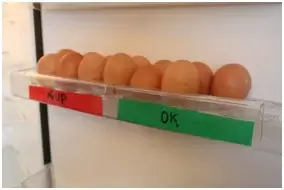5S Method in the Fridge? A well-organized workplace is essential! Regardless of whether it is in your professional life or at home. In Lean Management, the main tool for improving the quality of a workplace, and thus creating the basis for its improvement, is the
5S Method. See how to implement the 5S Method in your refrigerator in a practical way. Find out how to use the
Training Within Industry program to create
Standardized Work Instructions or SOP for cleaning a refrigerator.
What is the 5S Method?
A well-organized workplace is essential! Whether it is at work or home. In Lean Management, the main tool for improving the quality of a workplace, and thus creating the basis for its improvement, is the 5S Method. The name of the 5S system is derived from the following steps, starting with the letter “S”:
- S – Sorting (jap. Seiri)
- S – Systematics (jap. Seiton)
- S – Cleaning (jap. Seiso)
- S – Standardization (jap. Seiketsu)
- S – Self-discipline (jap. Shitsuke).
The 5S Method has been practiced in industry for several decades. Its use increases the comfort of the work of operators and significantly improves all key indicators for measuring the effectiveness of enterprises (KPIs). The 5S system is not only for industry, and is currently used in services, administration, IT and health care. However, nothing prevents you from also using it in your home environment!
The implementation of the 5S system should start with those areas that, on the one hand, concern a significant number of people, and on the other hand, where various operations are often performed. An additional selection factor should also be whether a given position is burdened with a large amount of waste (Japanese: muda). At home, the refrigerator is such a place. We open it at least a dozen times a day. We often put products there, move them, and also take them out. Everyone uses the refrigerator at home. Each refrigerator is also full of problems. Each of us have certainly encountered some deeply hidden and expired products there. The fate of these products is always the same: they go straight to the bin. In this way, on average, the average family loses as much as PLN 600 per year! This amount of money is enough to go to the cinema every month. Often, especially after shopping, a refrigerator may look like in Figure 1.

Fig. 1. Refrigerator before the implementation of the 5S Method
No! This is not a picture of your fridge! Although it probably looks similar. The question is: what should be done in order to keep order in your refrigerator forever? You need to implement and maintain the 5S system in it! It costs nothing and can bring you significant financial benefits.
I will show you a diagram below of how to make your refrigerator a place of delight, order, and one that is easy to use!
1.S. – Sorting products
In this step, you need to empty the entire refrigerator of all food. Then check each of them carefully. When sorting, throw out expired products into the bin, take those that are not needed from the refrigerator, and divide the necessary and edible ones according to the categories that suit you (Figure 2).

Fig. 2. Sorting products into groups in 5S Method
Sorting is not only about separating required products from unnecessary ones. This is primarily the moment that will determine the arrangement of items in your refrigerator.
2.S. – Systematizing the layout of products
At this stage, you know what products you are going to keep in the fridge. You now need to design a place for them in the refrigerator. In production, it is called the “stand layout”. This is the time to experiment and move products between shelves. Spend a large amount of your time on this. This breakdown will not only determine how the refrigerator is used, but also control the expiry date of the products (Figure 3).

Fig. 3. Designing the placement of products in the refrigerator
There are a few tips that you can use to organize your food in the refrigerator:
- Do not store open milk on the refrigerator door. As a result, it will undergo frequent temperature changes, and its shelf life will be much shorter than assumed.
- Store vegetables and fruits in the bottom, closeable drawers. The temperature in them is around 10 degrees Celsius. It is perfect for fruit and vegetables. Importantly, it is more humid there – like in a cellar.
- Store short-lived products on the middle shelves. The temperature here is optimal for keeping cheese, meat and yoghurt fresh.
- Store long-term products in a warmer place in the refrigerator. Usually these are the top shelves. In my refrigerator, the airflow is from the top (which is unusual), so the lower shelves are warmer. This is where you should store jams and preserves. Where it is colder, things will deteriorate faster. Good acidifying bacteria grow at a higher temperature, and harmful putrid bacteria at a lower temperature.
- Keep products that are happy in low temperature as close to air as possible. It’s the top shelf in my refrigerator. It’s the perfect place for beer, milk or juice.
Now that you know how to arrange the items in your fridge, you can move on to the least pleasant part – cleaning.
3.S. – Cleaning the refrigerator and preparing its autonomous maintenance
This step is not just a one-time thorough cleaning of the entire refrigerator! It is the design of the refrigerator cleaning schedule and the development of the
Work Instructions for the refrigerator cleaning operation. For this purpose, I recommend the
SOP Software which is based on the
Training Within Industry Job Instruction method. The key is to make the refrigerator permanently clean! Not only after one thorough cleaning.
This step is not so different than the
autonomous maintenance of machines, which is a
part of TPM. There, a maintenance schedule is also drawn up for key machines, and then standards for its preparation are created. The purpose of the cleaning in the TPM System is to identify any defects before they become breakdowns. In addition, TPM is precisely about cleaning machines less often, and rarely doing it thoroughly. Why? Because cleaning more often is simply easier. At this stage of the implementation of the 5S system in the refrigerator, the instructions specify the place that we want the household members to carefully clean, and more importantly – to check. It is an introduction to standardizing work.
4.S. – Standardization of using the refrigerator
This stage is the implementation of the plans designed in the first three steps. But that’s not all. It is during the standardization that various solutions are created to help maintain order in the refrigerator and to facilitate its use. I always say that the 5S system is not only about maintaining order in the work area, but also about improvement. Thanks to standardization, many ideas can be implemented to improve the use of the refrigerator:
Kanban
A two-container Kanban system for eggs (Figure 5). Thanks to this, it is easy to manage the number of eggs in the refrigerator. Eggs should be taken from the green zone. When it is empty, remove the container and put the second container with eggs from the red zone on the green one. The empty egg tray is placed on the red zone in the free space. For a person doing shopping, it is a sign that you need to refill it – buy eggs.

Fig. 4. The Kanban system that supports the ordering of eggs
Labels
Labels with the expiry date for open products and the determination of the direction of material flow by the FIFO principle (Figure 6). The developed standard says that when a product is opened, the date to which the product can be safely used is written on the self-adhesive label. The label is then attached to the product. Of course, this date is entered based on the recommendation of the manufacturer of the product. The arrows drawn on the stickers are meant to show the direction of adding products to the refrigerator so that those with the shortest expiry date are closest to the person using the refrigerator.

Fig. 5. Management of the expiry date of products in the refrigerator
Meal preparation
Preparation of containers for meat, vegetables and fruits (Figure 7). The standard says that after shopping, we should not put these products in the refrigerator, but instead put them into special containers that extend their shelf life. Of course, the containers are also marked with the aforementioned expiry date labels.

Fig. 6. Standard for the storage of meat, vegetables and fruits
Two bins Kanban
The Kanban system for managing the stock of milk cartons (Figure 8). The rule is that the refrigerator can contain a maximum of two cartons, of which only one can be opened (green box). After it is used, the empty box is thrown into the bin, and the box from the red zone is placed in the green zone. The red zone informs a person that a new carton of milk should be added (buy it or take it from the storage outside the refrigerator).

Fig. 7. The Kanban system for managing the stock of milk cartons
The min/max levels were also determined on the containers with ketchup, mayonnaise, or sauces. These levels depended on the frequency of their use. However, for the developed solutions to function, one important feature is needed among the household members: self-discipline.
5.S. – Self-discipline in maintaining the developed standards
This step involves the designing of a refrigerator order
auditing system. Such a system can only function when clear rules are prepared and when the household members are trained regarding them. Some exemplary rules that affect the maintenance of the 5S system in the refrigerator are provided below:
- Only put your things in the designated places.
- On each opened product that has an expiry date, attach a label stating when it should be consumed by.
- Follow the schedule and cleaning instructions for the refrigerator.
- If any place in the refrigerator gets dirty, clean it immediately.
- Follow the FIFO rules.
When establishing rules and checking compliance with them, remember that an audit is not a control. An audit is an opportunity for improvement. It is supposed to indicate any room for improvement in terms of workplace organization. An audit is not about stigmatizing people who use a specific area. People naturally go back to their old habits, so auditing is a necessary stage when building self-discipline.
Summary: 5S Method
The 5S Method is not only about cleaning the workplace, in this case, the refrigerator, but it is far more than that! It is an improvement in the quality of the workplace. The main goal of the 5S Method is to ensure that any mess in the workplace will never arise. The motto of the 5S system is: everything has its place and everything is in its place. Just as a refrigerator, thanks to the use of the 5S system, can look great and fulfill its role perfectly, you can also apply this practice in any other area of your home. However, this is only possible when the selected area is organized in such a way that people want to use it according to the newly established rules. So remember to implement changes together with your household members. The 5S system long ago went beyond production. It can be used wherever people share a certain area. Try this. Your partner or your household members will surely be pleased when you take such an initiative!
Takeaway: 5S Method
The article discusses the application of the 5S Method, a principle from Lean Management, to organize and improve the efficiency of a household refrigerator. The 5S Method, traditionally used in industries to enhance workplace quality and effectiveness, comprises five steps: Sorting, Systematizing, Cleaning, Standardization, and Self-discipline. These steps help in managing and maintaining a clean, efficient refrigerator, leading to financial savings and better food management.
- Sorting Products: This involves emptying the fridge, discarding expired or unnecessary items, and categorizing the remaining items.
- Systematizing Layout of Products: After sorting, products are systematically arranged in the fridge. This step includes practical tips like storing milk away from the door to avoid temperature fluctuations and placing perishables at optimal locations for freshness.
- Cleaning and Autonomous Maintenance: Beyond a one-time cleaning, this step involves creating a cleaning schedule and developing standardized instructions for ongoing fridge maintenance.
- Standardization of Usage: This stage implements the plans from the previous steps and introduces systems to maintain order, such as a Kanban system for eggs and milk, and labeling for expiry dates.
- Self-discipline in Maintaining Standards: The final step is about creating and adhering to rules for fridge use and cleanliness, ensuring long-term success of the implemented system.
The 5S Method transforms the fridge into a well-organized, efficient space, preventing waste and making it user-friendly. The approach is adaptable to other areas of the home, promoting overall improvement in household organization and management.
















